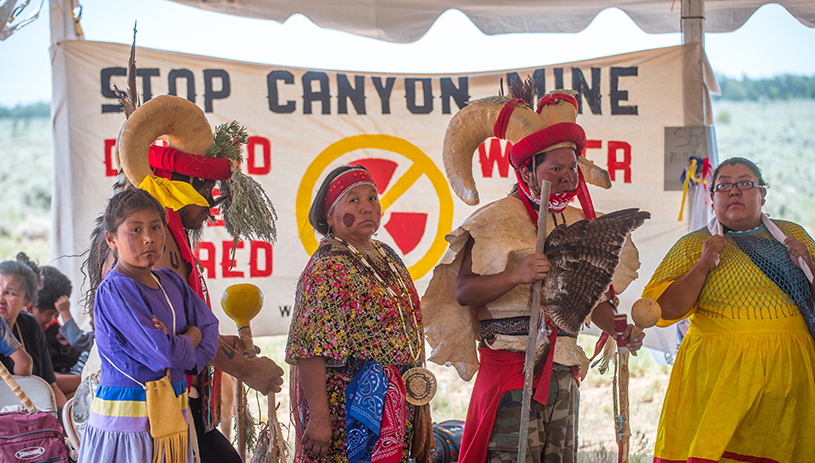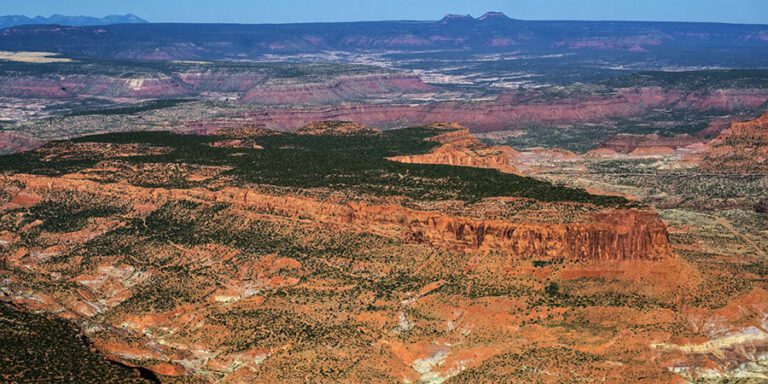
White Mesa Ute community leaders testify in Washington D.C. about how Utah’s White Mesa uranium mill, near Bears Ears, affects them.
Anferny and Yolanda Badback live just a few miles down the road from the aging White Mesa uranium mill, which supplements its uranium ore-processing business by accepting radioactive waste from around the world for processing and disposal.
In February 2024, Yolanda and her son, Anferny, leaders of the White Mesa Concerned Community group, which works to protect the Ute Mountain Ute community of White Mesa from the nearby uranium mill, traveled to Washington, D.C. to share their concerns in a hearing before the Organization of American States’ Inter-American Commission on Human Rights.
Testifying about the White Mesa Mill

The hearing, titled “Impacts of Uranium Exploitation on Indigenous Peoples’ Rights,” had been requested by the New Mexico Environmental Law Center to address how Indigenous peoples across the Western United States feel unheard by state and national leaders when it comes to uranium pollution.
Anferny Badback delivered powerful testimony at the hearing, saying:
“Sometimes when the mill is running, it smells like chemicals at my house. Our young ones are starting to get asthma, and nobody knows why. They never had asthma before. We are concerned about the pollution of our well water. Most of us don’t drink our tap water — we purchase bottles of water.
The water under the mill is becoming more and more polluted and is moving toward our community. The acidity of the water is increasing, and heavy metals are rising. We used to drink the spring water for ceremonial purposes. We don’t do that anymore. We used to hunt for animals near our homes; we used to gather plants for baskets, and to eat. We don’t do that anymore as well.
Radioactive waste and contamination from the lands of the Cherokee, Spokane, Muscogee, and many other nations, including international waste from Estonia and Japan, has been shipped to the mill. More waste left behind from the U.S. government is coming in soon. They pit tribes against tribes, and we don’t support that.”
Yolanda Badback told the commission, “I want our community to be free of radiation. I want our kids to be growing up in a safe environment.”
Uranium mining affects many tribes

Native American advocates and activists from across the region, including Carletta Tilousi from the Havasupai Tribe and Edith Hood and Teracita Keyanna from the Navajo Nation, testified about how uranium mining affects their communities.
Former Havasupai Trial Council Member Carletta Tilousi told the commission, “We have been against uranium mining for decades because of the known risks to air and water, land and people.” Tilousi continued, “Uranium mining in the Southwest has scarred and left a horrifying legacy of death in our communities. Thousands of abandoned uranium mines on federal and tribal lands have not been cleaned up.”
Ore from the controversial Canyon uranium mine (renamed the Pinyon Plain Mine), which threatens the Havasupai Tribe’s sacred mountain, Red Butte, not far from the Grand Canyon, is expected to be trucked across Navajo Nation lands to the White Mesa Mill for processing.
The federal government responds
Given a chance to address the witnesses and the commission, government representative John Lubinski, director of the Office of Nuclear Material Safety and Safeguards at the Nuclear Regulatory Commission, claimed, “We’ve found that our approach to environmental justice in our programs, policies, and activities has worked well, and the [recent] assessment identified opportunities for programmatic and policy enhancements as we move forward.” Lubinsky did not elaborate.
The Organization of American States’ Rapporteur on Indigenous Rights Commissioner Arif Bulkan delivered a more satisfying response, saying, “It’s been held by this Commission that protecting the particular relationship between Indigenous peoples and their lands and resources is linked to their very existence, and thus warrants special measures of protection. These are basic standards that acknowledge the primacy of Indigenous peoples in this region, and they’re a measure of redressing historic injustices, injustices that involve removal from the land, and continuing inequalities as a result…” Bulkan continued, “…part of that protection and respect would include observing the FPIC principle — free, prior, and informed consent — as distinct from consultation.”
Free, prior, and informed consent from tribes
Though steps taken by the Biden administration regarding Native American affairs in recent years have brought about some improvements, the U.S. still has a long way to go to honor Indigenous peoples’ sovereignty under international law. Bulkan’s statement served as an important reminder for U.S. government officials of the importance of free, prior, and informed consent for activities which affect tribes, as outlined in the United Nations Declaration on the Rights of Indigenous Peoples. The United States recognized the declaration in 2011.
Waiting and wanting justice for White Mesa
Anferny Badback closed his testimony by saying, “We’re concerned about the health of our young ones and our elderly in our Ute community. We want the mill shut down and [to] properly be cleaned up. We want the mill and its contamination to be moved where it can’t hurt any living things. … Please help us. We’re waiting and wanting justice.”
The full hearing, including the U.S. government’s and commissioners’ responses, can be heard here




